-
EngineSC 6.2L V8
-
Power707 HP / 650 LB-FT
-
Transmission8-Speed Auto
-
0-60 Time3.5 Seconds (est.)
-
Top Speed199 MPH
-
DrivetrainRear-Wheel Drive
-
Curb Weight4,439 LBS
-
Seating2+3
-
Cargo16.2 CU-FT
-
MPGTBD City / 20 HWY
-
Base Price$59,995
-
As Tested Price$65,265
Just a few hours previous, I'd gotten behind the wheel of the Hellcat for the first time, letting its hyperbole-spitting, supercharged V8 Hemi pull me yieldingly through Portland's morning commuter traffic. Lulled into a cocky certainty by the Challenger's good manners at low speed, I drove the throttle just a hair too deep, too fast when I ran on to the highway ramp. For just an instant the rear tires were utterly drenched in torque, and the back end of the big Dodge loosened up like a drift car on a wet track. Throttle steer lives at the fleeting whim of your right foot in this car.
It was no big thing to lay off the gas and pull the Hellcat back in line as I entered the highway, but the incident did get me to thinking: What will this car do to me on a road course?
With the track talk ended, I picked up a helmet and a head sock – stand-ins for the whip and the chair every good lion tamer needs – hoping like hell I wouldn't end up as a gravel-track snack for the new biggest predator in the muscle car circus.

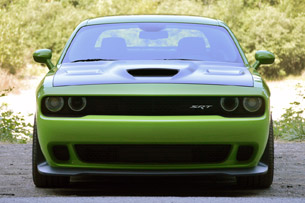
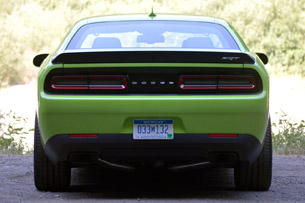
The race amongst the Detroit Three to offer the most outlandish pony car has been heating up for some time, as you well know. Chevrolet will sell you a Camaro ZL1 that produces a bruising 580 horsepower and sprints to 60 miles per hour in under four seconds, while Ford's outgoing Shelby GT500 makes an astonishing 662 hp on 93 octane fuel, and still tops the list in terms of power-to-weight for under six figures.707 hp and 650 lb-ft are not only good enough to wallop the GT500, they make some supercars start to feel a mite less exotic.
Until today, the Dodge Challenger's efforts in the 21st-Century Pony Wars have been stylish and quick, but ultimately lagged behind Ford and Chevy fare. The most potent Challenger 392 was anything but slow in its last, 2014-model-year iteration, but its naturally aspirated Hemi V8 was never quite stout enough to pull its two-ton curb weight into contention with its top-flight rivals.
Just a few weeks ago, Dodge put the performance-motoring community on notice that it wouldn't accept third billing any longer, revealing that its supercharged 6.2-liter Hellcat V8 engine would kick out an astronomical 707 horsepower and 650 pound-feet of torque. Those numbers are not only good enough to wallop the cock-of-the-walk GT500, they make some supercars start to feel a mite less exotic as well.
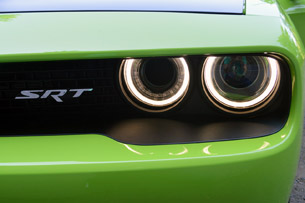
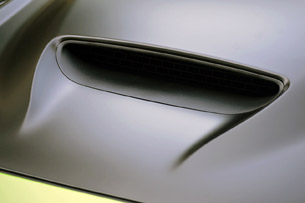
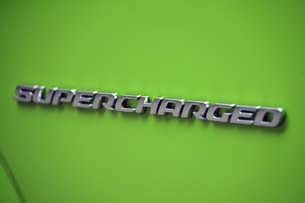
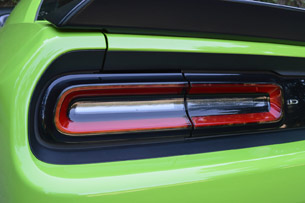
The Lamborghini Aventador makes seven fewer horsepower and 141 fewer pounds-feet of torque while costing seven and a half times more than the Hellcat's $59,995 sticker. The McLaren 650S is some 60 hp shy and about five times the cost, while the Ferrari 458 Speciale can't even muster 600 hp for almost $300,000. In fact, even in today's horsepower-happy climate, you're really looking at spending a half million or more if you want to climb the 700-hp mark in a straight-from-the-factory product.Attempts to unleash all of the new Hemi's power from a standing start result in the near-instant liquefaction of a lot of good, expensive rubber.
Unless you dial up your local Dodge dealer, that is.
SRT has gone far enough into the bonkers realm with the Hellcat engine for Dodge CEO Tim Kiniskis to credibly call this a "science-project car." Sure, the cast-iron block may still be powder-coated in the same orange as Hemi engines past, but technology abounds in this supercharged 6.2-liter V8. The forged-steel crankshaft is ultra hard and durable; the pistons are of forged-alloy construction and connected to powder-forged rods; heat-treated, aluminum alloy cylinder heads offer "superior thermal conductivity" and the hollow-stem exhaust valves are sodium cooled in an engine where heat buildup is a very real issue. And, of course, SRT has built a supercharger to beat the band. The twin-screw blower displaces 2,380cc of air per rev, creates a regulated max boost of 11.6 psi, and sounds like the Devil riding a bobsled from Heaven to Hell when it's fully maxed out at 14,600 rpm.
I made a few hilarious attempts to unleash all of the new Hemi's power from a standing start, and the result, predictably, is the near-instant liquefaction of a lot of good, expensive rubber. Fun, but slow, as you can see below.
No, better use of the massive torque – all 650 pound-feet of it available at 4,000 rpm – is found in the impressive lurch forward when the throttle is matted at highway speeds. With the steering wheel pointed straight ahead, the only issue with accelerating for a pass in the Challenger SRT is staying near enough to the speed limit that you might not lose your driver's license if police radar is on hand to track you. From a 60-mph start, the Hellcat needs only the merest insinuation on the gas to bolt to triple digits. I've driven a handful of 200-mph cars before, but few of them seem to offer up the possibility of the double ton in real-world circumstances like this Dodge. I'm not saying I could hit the 199-mph limit, but I am saying the Hellcat didn't stop pulling hard before I chickened out (or on the track, ran out of tarmac).
PIR was the destination for the afternoon, but I was able to fill the morning by testing the Hellcat's legs on some truly lovely roads along the Columbia River. Anyone that has traveled this way knows that both the Oregon and Washington sides of the river are blessed with driver's roads as good as just about any in the country, albeit dotted with slow-moving sightseers and tourist-choked vista stops, as well. Truth be told, the stop-and-go traffic punctuated with the occasional fast corner and nuanced river bend, made for a great use of the Challenger's performance suite.
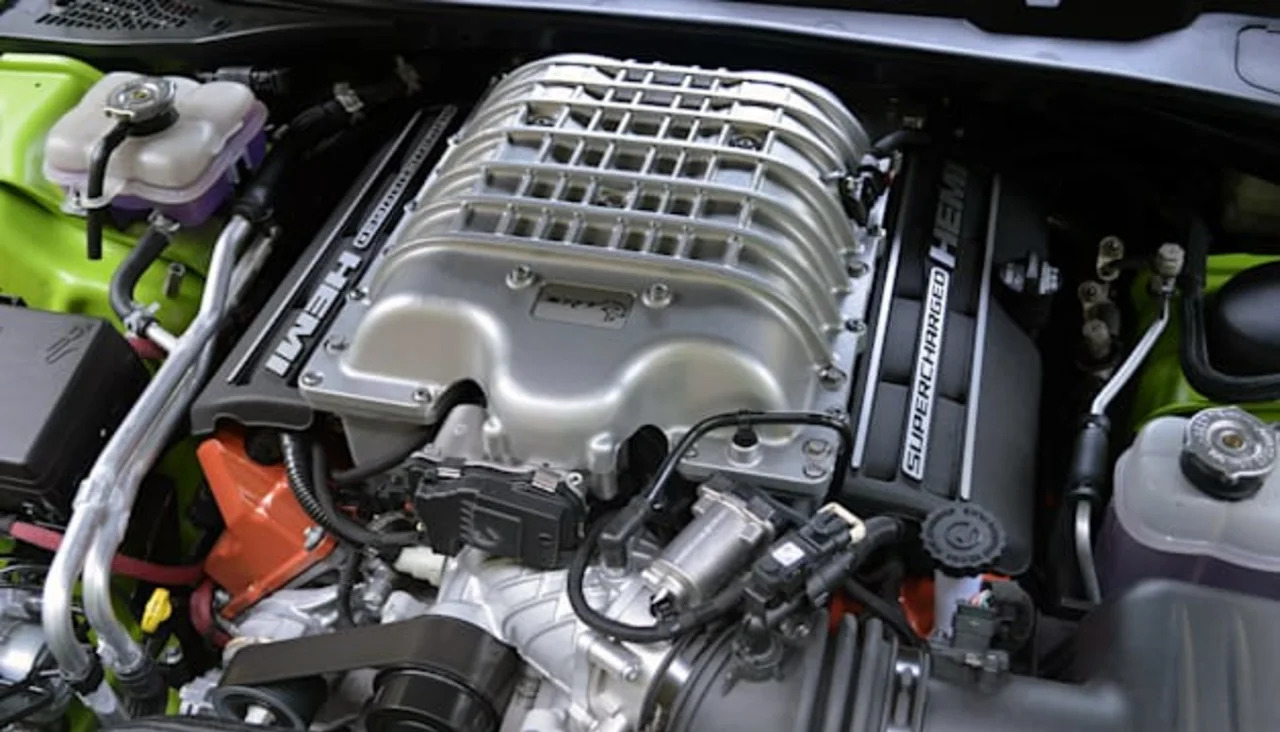
In the wide-open spaces that run over hill and through pine forest around the Columbia, the SRT proved itself remarkably quiet, relaxed and easily tractable from sweeper to sweeper. Sure, when I dug into the Hellcat's power reserves, the exhaust note and supercharger whine were more than enough to wake any sleeping passengers, but as a kind of American grand tourer, this Challenger should have few equals.As a kind of American grand tourer, this Challenger should have few equals.
The road surfaces were mostly well maintained and smooth on our river route, and didn't offer much to upset the ride quality of the Challenger, either at pace or when cruising. Dodge's new Drive Modes (Default, Sport and Track) alter shift speeds, steering weight, traction control and suspension response in the SRT, and the middle Sport mode proved well suited to occasionally aggressive cornering, without letting much road harshness filter in by way of the seats or floorboards. The long, wide coupe still has a lot of body to be piloted from corner to corner on the really tight sections of the road, but the truth is that it responded with neutrality and quickness at a moderate pace.
"Nimble" wasn't the word that sprung to mind after turning more than 100 miles on public streets, but "confident" would be a fair one.
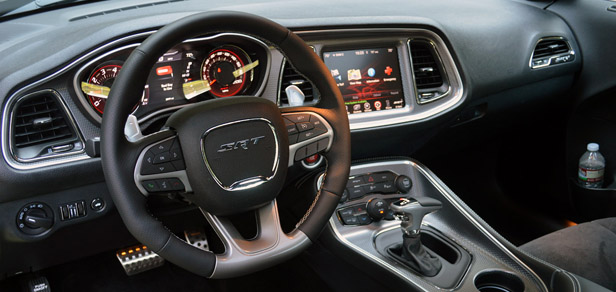
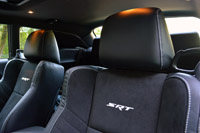
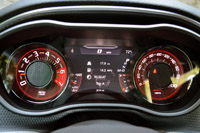
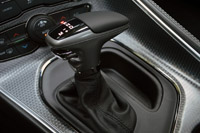
In terms of a big GT car (in addition to a bragging-rights muscle car), Dodge has done the Challenger a service in terms of renovating its interior, too. A large, bright, and easy-to-operate UConnect infotainment screen lords over the center stack and offers a wealth of infotainment options to go with a great supply of vehicle settings. There's an aluminum bezel that bejewels the instrument cluster, and another one that wraps around the controls and cupholders on the central tunnel. As ever, the SRT seats are beefy and comfortable, but with enough lateral grip to keep all but the skinniest drivers from sliding around under a cornering load. Dash and door plastics have been given a glaze of rubbery texture that exudes higher quality than in the outgoing car, but what's impressive in the sub-$30k base of the model range does feel a bit underwhelming in a $60k-car. The company clearly put most of the Hellcat-specific budget in the engine – and I'm fine with that.The interior feels a bit underwhelming for a $60k-car. Dodge clearly put most of the Hellcat-specific budget in the engine – and I'm fine with that.
Of course, it looks the part, too. I'm convinced that a lot of Challenger's success up to this point has been its striking use of 1970s design cues with enough modernity to keep non-Baby Boomers interested. The 2015 Challenger doesn't change much of that, but it does amp up the equation, especially in Hellcat guise, with a revised front end, halo-ringed headlamps and a mean-ass, hood-mounted NACA duct sucking in as much fresh air as you're willing to feed it. Fittingly, along with the new wheels and revised bodywork, SRT has made sure the engine bay drops jaws when the hood is popped.
Eventually, over the next months and years, we'll bring you plenty of tales of this newest Challenger, in all of its trims and with each one of its engines, and will, I'm certain, reinforce to you that it makes a very fine, fast road car. But I started this tale with a racetrack, and it's on some kind of track that Dodge believes a lot of its eventual Hellcat owners will find themselves. Muscle car or no, all that power makes this the closest thing to a road-legal-racecar Challenger since the swanky '70s.
And, like another racing luminary, Richard Petty once pointed out, "The good Lord doesn't tell you what His plan is, so all you can do is get up in the morning and see what happens next." In other words, I had to track the thing.
PIR is a nearly two-mile track with very little elevation change, a meandering back section and long, near-straights on either end of the start/finish line. Half of it makes the Hellcat feel like a hero, while the other half calls into question the physics behind a massive engine sending monumental power to just the rear wheels of a 4,400-pound muscle car.
At every point of interaction on the circuit, I found the Hellcat experience to be more or less dominated by the omnipotence of the 6.2 Hemi – for good and for bad. Turn 8 is a very shallow S-curve that sets one up for the great, long sweeping Turn 9, where I progressively became braver, faster and less concerned about planting the passenger-side headlight into the concrete wall directly off the right hand side. The aforementioned worried driving instructors had set up a very conservative braking box coming out of 9, but even at my fastest tilt, I never once mistrusted the tremendous braking force under my foot.
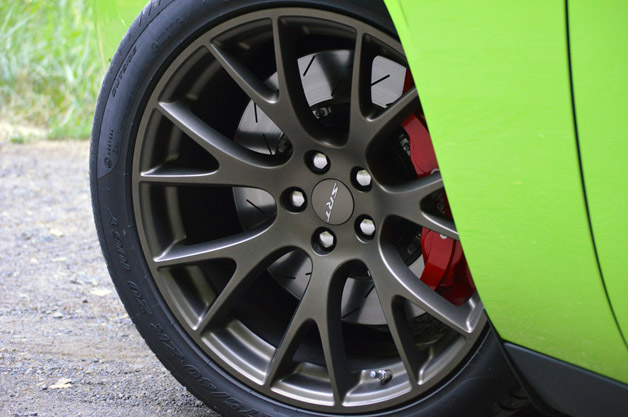
Dodge has fitted crazy-huge 15.4-inch front rotors with six-piston calipers to retard the SRT's copious power, along with 13.8-inch discs and four-piston calipers on the rear. The result of all the stopping power (and the grippy, 275-section Pirelli PZero tires) was braking response that, on few occasions, left me just as short of breath as the standing starts had earlier. I was never allowed more than four consecutive laps of the two-mile course at a go, but in that timeframe (and under heavy use all day), the brakes never seemed to wilt, either.With all the good that the SRT team has wrought here, there's still no getting around the fact that the Challenger is not a natural racecar.
I can also offer full-throated enthusiasm for the Torqueflite eight-speed automatic transmission. With Track mode engaged, the automatic programming was quick to respond to requests for more power, never seeming to be caught wrong-footed on any section. Still, shifting for myself was more enjoyable (even though that mostly meant third and fourth gear at this venue), and the autobox was ultra responsive in that task, too. Dodge will sell you a Hellcat with a six-speed manual transmission, as well, but I wasn't ever in the right car at the right time to sample that hand-shaker on the circuit. Next time.
With all the good that the SRT team has wrought here, there's still no getting around the fact that the Challenger is not a natural racecar – at least for someone who is unused to pushing American-iron-heaviness from curb to curb. As I mentioned earlier, the Hellcat is almost always up for a throttle-induced bout of oversteer, so holding the go-pedal steady while taking a quick line through the half-circle corners that make up PIR's Turns 4, 5, 6 and 7 proved, well, challenging. Even with plenty of grip available most of the time, there's so much weight constantly desirous of changing direction that hustling the Dodge in the twisty bits left me either too slow or out of sorts upon exit. The steering is quick enough, but numb, which didn't help speed me up, either.
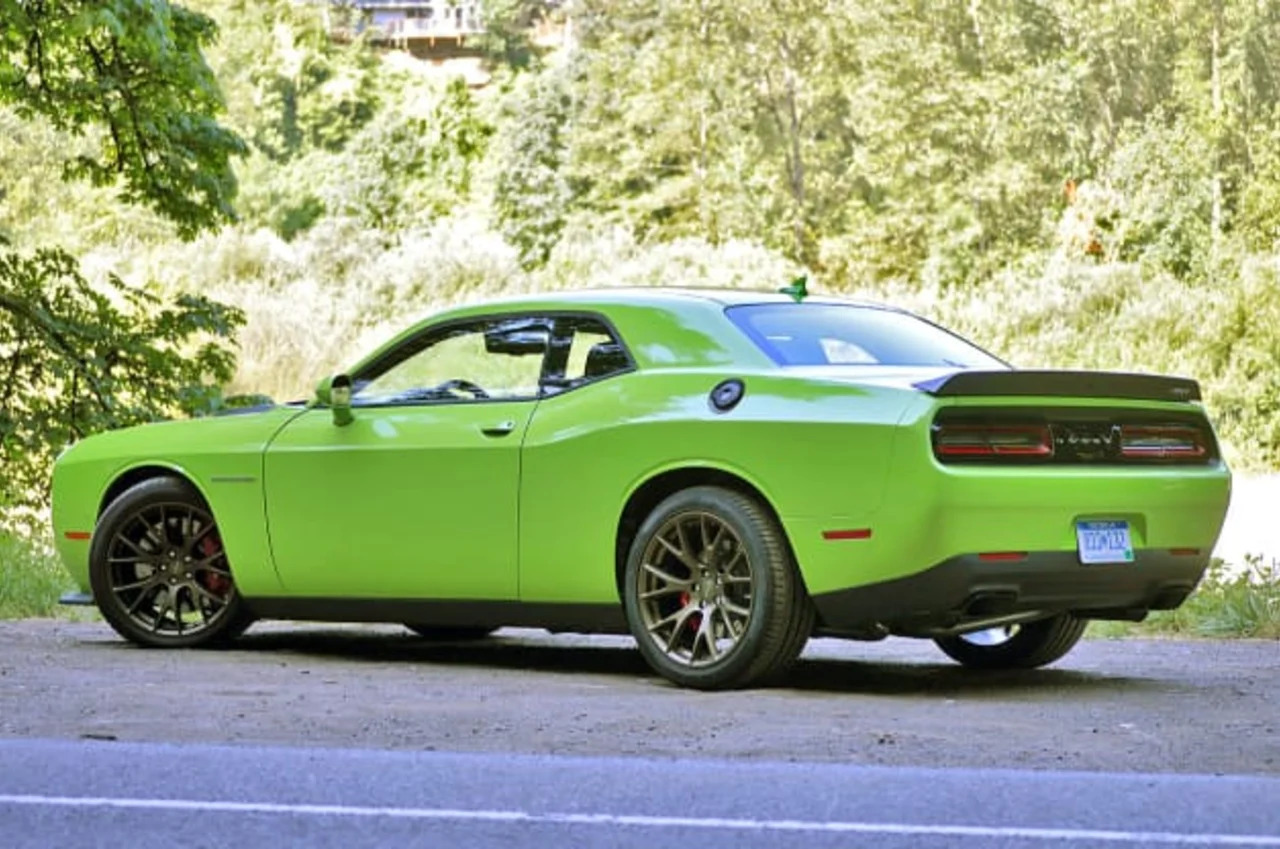
I'll be the first person to tell you that some of that slowness is down to me being the driver. It's like Buddy Baker once quipped, "He ran out of talent about halfway through the corner." I can own that. But it's also true that the Hellcat, for all of its phenomenal power, isn't the kind of thoroughbred that makes its driver better on a track day.The SRT can truthfully boast of being the world's top-dog muscle car, as well as one of the most impressive performance-per-dollar cars ever.
I actually think that's fine, too. This is, after all, a muscle car, guys. And where the mission of cars like the Camaro Z/28 and Ford Mustang Boss 302 have expanded the scope for traditional nameplates, there's more than enough room for the bigger personality of this hellacious Mopar, too.
Dodge has taken the car-interested world by storm with this Challenger SRT Hellcat, creating a buzz for the entire model range that should do exciting things for the Dodge brand in 2015. The SRT can truthfully boast of being the world's top-dog muscle car, as well as one of the most impressive performance-per-dollar cars, well, ever. As the front man for this exciting new generation of super pony cars, I expect it to dominate the conversation for the foreseeable future and be easily tracked by the cloud of smoke and sizzle of rubber it leaves in its wake.
Welcome to first place, Hellcat.
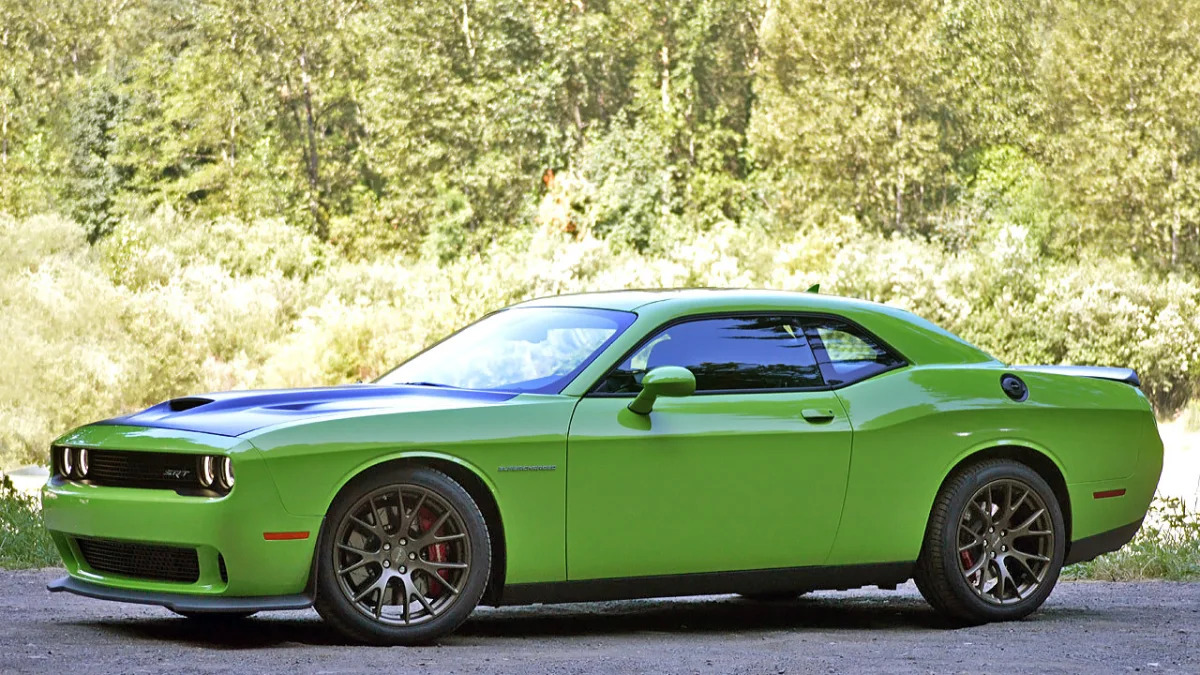









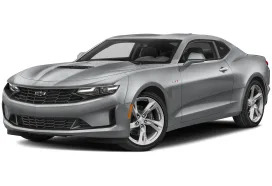
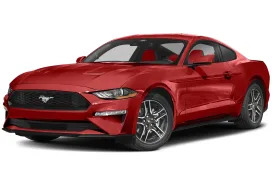

Sign in to post
Please sign in to leave a comment.
Continue